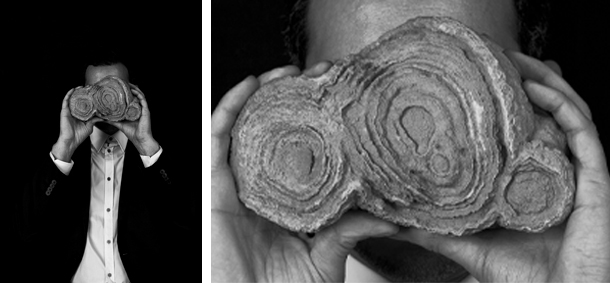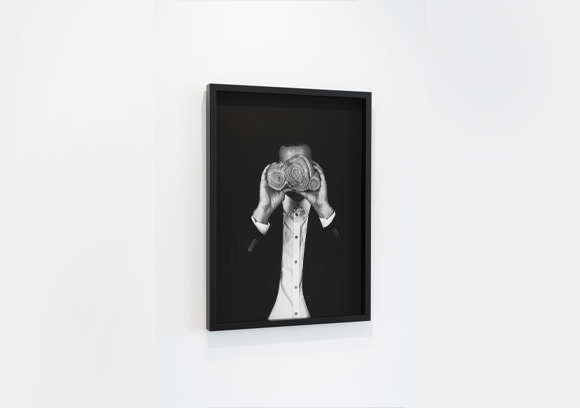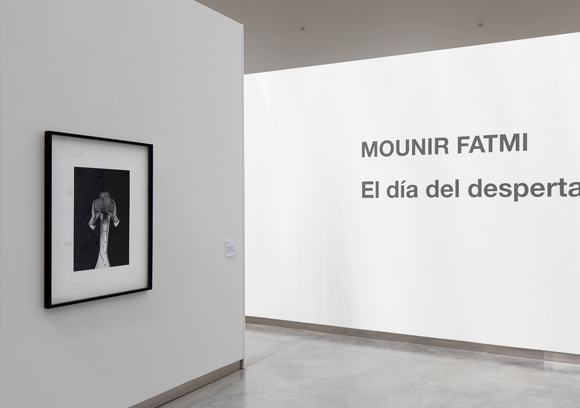| |
|
|
51.
| The Blind Man |
| |


2015, C-Print, 50 x 70 cm.
Exhibition view from Peripheral Vision, Tokyo.
Courtesy of the artist and Art Front Gallery, Tokyo.
Ed. of 5 + 2 A.P.
'' In his self-portrait, mounir holds a stromatolite rock from the Moroccan desert, one of the oldest fossil forms that he purchased at auction,
up to his eyes like a pair of binoculars. Besides blocking his sight, this prevents the visitor from looking at him, suppressing part of his identity
while disrupting the notion of portraiture as being about the face and the eyes. ''
Anna Sansom, Damn Magazine, 2017

The Blind Man
Exhibition view from Peripheral Vision, Tokyo.
Courtesy of the artist and Art Front Gallery, Tokyo.

The Blind Man
Exhibition view from The day of the Awakening, CDAN, 2018, Huesca.
Courtesy of the artist and ADN Galeria, Barcelona.
|
|
|
|
|
| Collection of Fondation Nationale des Musées, Rabat
Autoportrait photographique en noir et blanc, « L’Aveugle » représente mounir fatmi, vêtu d'une chemise blanche et d'une veste noire, tenant à hauteur de ses yeux, telle une paire de jumelle, un stromatolithe du désert marocain acquis aux enchères. L'œuvre s'inscrit dans une série d’autoportraits, à travers laquelle l’artiste photographie différents objets liés à l’identité marocaine qu’il place systématiquement devant son visage. Les stromatolithes sont une des plus anciennes formes fossiles, apparues il y a 3.5 milliards d'années, et renvoient aux origines de la vie sur Terre. Leur structure, souvent calcaire, a pour origine le milieu aquatique et les fossiles, très répandus dans le désert marocain, se retrouvent fréquemment vendus aux touristes sur le marché noir.
Les photographies de la série « L’Aveugle », interrogent le rôle du patrimoine historique. Elles explorent les rapports de l'individu à son héritage culturel et à l’histoire. Elles tentent de définir la relation de l'artiste à la question identitaire et expriment le choix d'une mise à distance. Les photographies relèvent l'ambivalence intrinsèque des marqueurs culturels et identitaires. Le fossile renvoie à l'idée de la mort et à l'origine de la vie. L'objet mentionné est censé être typique à la fois de l'identité d'un pays et du sujet représenté et son discours tiendrait autant du général que du particulier. Et pourtant, l'objet demeure muet. Plus encore, il tend à occulter le sujet, à faire disparaître l'individu derrière de trop évidentes significations. Si les marqueurs culturels participent à fonder l'identité, ils constituent également un réservoir presque inépuisable de stéréotypes sociaux et culturels qui empêchent le sujet d'être pleinement lui-même. Ces premiers l’empêchent d'être perçu comme un individu à part entière et libre de ses choix, comme autre chose qu'un simple reflet ou produit de son environnement. Pour l'individu qui en est affublé, ces marqueur identitaires se révèle aveuglant : il conditionne sa perception du monde, ses goûts et ses choix.
Mêlant figuration et abstraction, avec leur jeu de cercles concentriques dont l'esthétique renvoie aux nombreuses expérimentations géométriques de l’artiste, les autoportraits « L’aveugle » associent distance et proximité avec le sujet représenté. Leur représentation hétérogène et hybride se propose comme une forme ouverte aux observations et interprétations diverses. Le fossile substitue ainsi à la photo d'identité un jeu de masques ou le sujet retrouve sa liberté en jouant avec les stéréotypes et en les extériorisant, ce qui leur ôte leur pouvoir de conditionnement.
Dans tous les autoportraits de mounir fatmi, de « Calligraphie de Feu » à « Peripheral Vision », en passant par « Mal de frontières », l'autorité figurative et la soumission de l'individu aux clichés sociaux, à l’histoire, à l'éducation ou à la culture sont contestées. Ils formulent un parti-pris esthétique de la mise à distance et de l’hybridation en élaborant des stratégies fondées sur les connexions, les correspondances artistiques et culturelles. La série « L’Aveugle » laisse finalement entendre que les perceptions de l'artiste s'étendent bien au-delà des simples apparences et de l'univers visible. Tel un Tirésias des temps modernes, il fait preuve d'une acuité visuelle qui lui permet de voir loin dans le passé sans que cela l’empêche de se projeter dans le futur.
Studio Fatmi, Février 2018.
|
|
A black & white photographic self-portrait, « The Blind Man » features mounir fatmi wearing a white shirt and a black vest, holding at eye level, like a pair of binoculars, a stromatolite from the Moroccan desert, purchased in an auction sale. The work is part of a series of self-portraits in which the artist photographs various objects related to Moroccan identity that he systematically places in front of his face. Stromatolites are one of the oldest forms of fossils; they appeared 3.5 billion years ago and take us back to the origins of life on Earth. Their structure, generally made of limestone, originated underwater; the fossils, commonly found in the Moroccan desert, are frequently sold to tourists on the black market.
The photographs from the series « The Blind Man » question the role of historical heritage. They explore the relation of individuals to their cultural heritage and history. They try to define the artist’s relation to the question of identity and express the choice to distance himself from it. The photographs highlight the intrinsic ambivalence of cultural and identity markers. The fossil is linked to the idea of death and to the origin of life. The mentioned object is supposed to be both typical of the identity of a country and of the represented subject, and his discourse has to do with the general as much as the particular. Yet the object remains silent. Furthermore, it tends to dissimulate the subject, to make him disappear behind too obvious significations. If cultural markers play a part in founding one’s identity, they also represent an almost endless source of social and cultural stereotypes that prevent the subject from being fully himself. They prevent him from being perceived as a full-fledged individual, free to make his own choices, as something else than the simple reflection or product of his environment. For the individual who carries them, these markers of identity turn out being blinding: they condition his perception of the world, his tastes and choices.
Combining figurativeness and abstraction with their set of concentric circles whose esthetic refers the artist’s numerous geometric experimentations, the « Blind Man » self-portraits associate distance and proximity with the represented subject. Their heterogeneous and hybrid representation offers itself as a format open to various observations and interpretations. In this way, the fossil replaces the ID photo with a play with masks where the subject recovers his freedom by playing with stereotypes and externalizing them, thus annihilating their conditioning power.
In all of mounir fatmi’s self-portraits, from « Calligraphy of Fire » to « Peripheral Vision » and « Border Sickness », figurative authority and the submission of the individual to social clichés, history, education and culture are contested. They formulate an esthetic choice to create distance and hybridization by elaborating strategies founded on connections and artistic and cultural correspondences. Finally, the series « The Blind Man » suggests that the artist’s perceptions go way beyond mere appearances and the visible universe. Like a modern-day Tiresias, he demonstrates a visual acuity that enables him to see far into the past without keeping him from projecting himself into the future.
Studio Fatmi, February 2018.
|
|
|
|